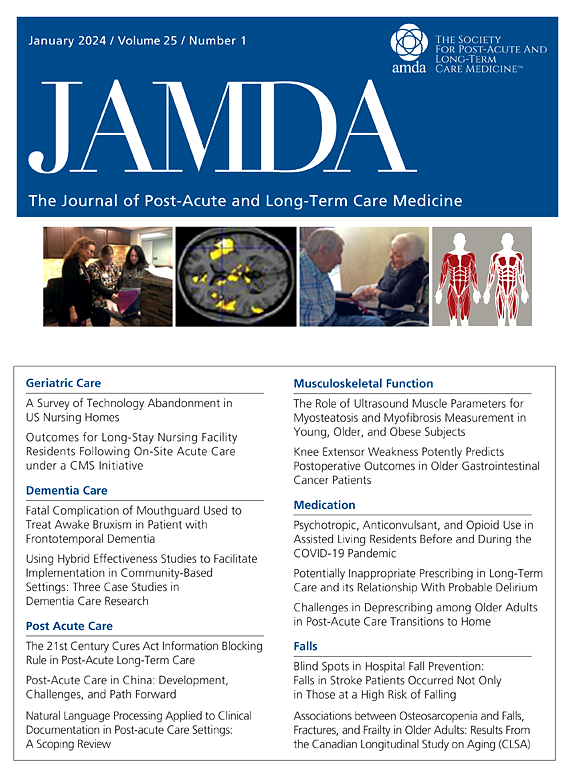个体化积极社会心理互动(IPPI)项目的嵌入式实用临床试验。
IF 3.8
2区 医学
Q2 GERIATRICS & GERONTOLOGY
Journal of the American Medical Directors Association
Pub Date : 2025-06-12
DOI:10.1016/j.jamda.2025.105700
引用次数: 0
摘要
目的:我们实施了一项基于证据的个性化积极社会心理互动(IPPI)计划的试点实用临床试验,该计划适用于养老院的痴呆症患者(PLWD)。我们试图回答以下问题:工作人员能否在6个月的时间里持续为登记的居民提供IPPIs ?IPPI的完成如何影响住院患者情绪的直接结果?我们能否追踪IPPI完成对最小数据集(MDS) 3.0中记录的远端(3个月和6个月)实际临床结果(即窘迫症状)的影响?设计:养老院工作人员完成了以情绪为中心的沟通的在线培训,并接受了提供IPPIs的培训,这些IPPIs是简短的(即10分钟),以协议为指导,一对一的偏好对齐,与PLWD互动。工作人员被要求在6个月内每周完成2次IPPIs。环境和参与者:来自7家养老院的130名居民。方法:对研究期间所有符合条件的社区养老院居民进行ippi前后观察情绪评估,并收集MDS 3.0数据。在基线、3个月和6个月时计算IPPI完成率、样本描述、情绪变化认可和窘迫症状的描述性统计数据和频率。结果:未死亡或未从养老院出院的IPPI参与者在6个月内平均完成45次IPPI。在59% (n = 2813)的IPPIs患者中,情绪立即从消极改善到中性/积极或从中性改善到积极,而在42% (n = 1994)的病例中,情绪保持稳定。MDS 3.0数据能够显示从基线到3个月和6个月的痛苦症状随时间的变化,其中大部分在干预期间得到改善。结论和意义:IPPI计划是一种有效的以人为本的干预措施。它可以整合到护理中,改善居民的情绪,并且可以在现有的临床数据中跟踪痛苦的症状。本文章由计算机程序翻译,如有差异,请以英文原文为准。
An Embedded Pragmatic Clinical Trial of the Individualized Positive Psychosocial Interaction (IPPI) Program
Objectives
We implemented a pilot embedded pragmatic clinical trial of the evidence-based Individualized Positive Psychosocial Interaction (IPPI) program for people living with dementia (PLWD) in nursing homes. We sought to answer the following questions: Can staff consistently deliver IPPIs to enrolled residents over 6 months? How does IPPI completion impact the immediate outcome of resident mood? Can we track the impact of IPPI completion on a distal (3-month and 6-month) pragmatic clinical outcome (ie, symptoms of distress) recorded in the Minimum Dataset (MDS) 3.0?
Design
Nursing home staff completed an online training on emotion-focused communication and were trained to deliver IPPIs, which are short (ie, 10-minute) protocol-guided, one-on-one preference-aligned, interactions with PLWD. Staff were instructed to complete 2 IPPIs per week per resident for 6 months.
Setting and Participants
130 residents from 7 nursing homes.
Methods
Pre- and post-IPPI observed emotion evaluations were completed and MDS 3.0 data were collected for all eligible residents in the nursing home community during the study period. Descriptive statistics and frequencies were computed for rates of IPPI completions, sample descriptives, endorsement of mood change, and symptoms of distress at baseline, 3 months, and 6 months.
Results
IPPI participants who did not die or discharge from the nursing home completed on average 45 IPPIs over 6 months. In 59% (n = 2813) of IPPIs, mood immediately improved from negative to neutral/positive or from neutral to positive, whereas in 42% (n = 1994) of cases, mood stayed stable. MDS 3.0 data were able to show change over time in symptoms of distress from baseline to 3 months and 6 months, with most improving during the intervention period.
Conclusions and Implications
The IPPI program is an effective person-centered intervention for PLWD in nursing homes. It can be integrated into care and improve resident mood, and symptoms of distress can be tracked in existing clinical data.
求助全文
通过发布文献求助,成功后即可免费获取论文全文。
去求助
来源期刊
CiteScore
11.10
自引率
6.60%
发文量
472
审稿时长
44 days
期刊介绍:
JAMDA, the official journal of AMDA - The Society for Post-Acute and Long-Term Care Medicine, is a leading peer-reviewed publication that offers practical information and research geared towards healthcare professionals in the post-acute and long-term care fields. It is also a valuable resource for policy-makers, organizational leaders, educators, and advocates.
The journal provides essential information for various healthcare professionals such as medical directors, attending physicians, nurses, consultant pharmacists, geriatric psychiatrists, nurse practitioners, physician assistants, physical and occupational therapists, social workers, and others involved in providing, overseeing, and promoting quality

 求助内容:
求助内容: 应助结果提醒方式:
应助结果提醒方式:


